Page 194 of 434
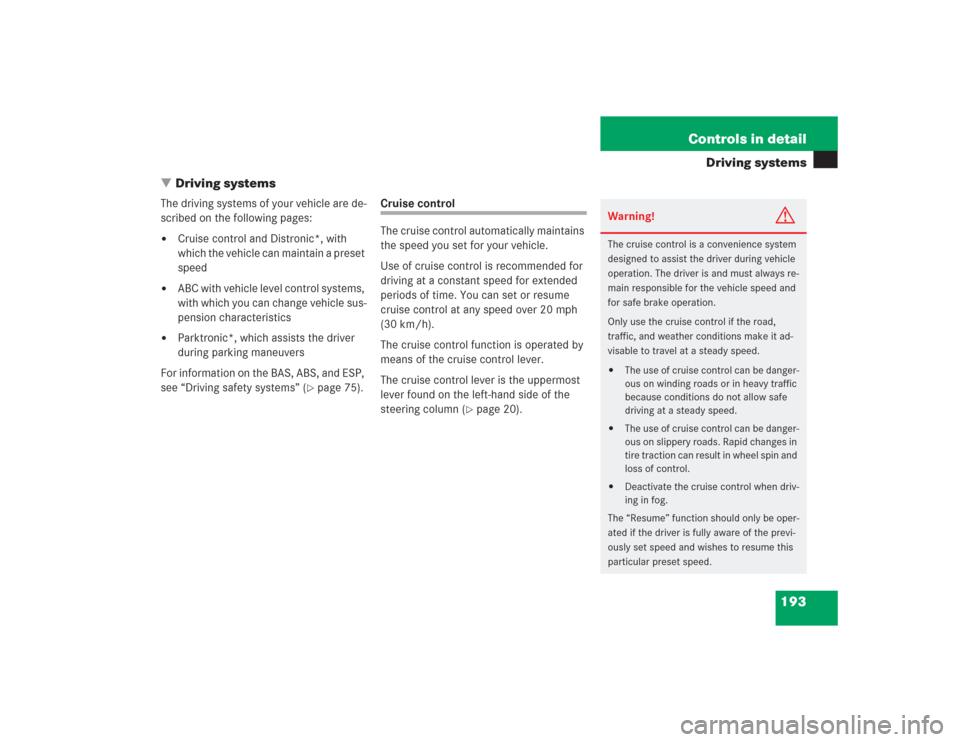
193 Controls in detail
Driving systems
�Driving systems
The driving systems of your vehicle are de-
scribed on the following pages:�
Cruise control and Distronic*, with
which the vehicle can maintain a preset
speed
�
ABC with vehicle level control systems,
with which you can change vehicle sus-
pension characteristics
�
Parktronic*, which assists the driver
during parking maneuvers
For information on the BAS, ABS, and ESP,
see “Driving safety systems” (
�page 75).
Cruise control
The cruise control automatically maintains
the speed you set for your vehicle.
Use of cruise control is recommended for
driving at a constant speed for extended
periods of time. You can set or resume
cruise control at any speed over 20 mph
(30 km/h).
The cruise control function is operated by
means of the cruise control lever.
The cruise control lever is the uppermost
lever found on the left-hand side of the
steering column (
�page 20).
Warning!
G
The cruise control is a convenience system
designed to assist the driver during vehicle
operation. The driver is and must always re-
main responsible for the vehicle speed and
for safe brake operation.
Only use the cruise control if the road,
traffic, and weather conditions make it ad-
visable to travel at a steady speed.�
The use of cruise control can be danger-
ous on winding roads or in heavy traffic
because conditions do not allow safe
driving at a steady speed.
�
The use of cruise control can be danger-
ous on slippery roads. Rapid changes in
tire traction can result in wheel spin and
loss of control.
�
Deactivate the cruise control when driv-
ing in fog.
The “Resume” function should only be oper-
ated if the driver is fully aware of the previ-
ously set speed and wishes to resume this
particular preset speed.
Page 246 of 434

245 Operation
Driving instructions
SL 55 AMG
Your vehicle is factory equipped with
“W”-rated tires, which have a speed rating
of 168 mph (270 km / h) or “Y”-rated tires,
which have a speed rating of 188 mph
(300 km / h).
An electronic speed limiter prevents your
vehicle from exceeding a speed of
155 mph (250 km / h).
Winter driving instructions
The most important rule for slippery or icy
roads is to drive sensibly and to avoid
abrupt acceleration, braking and steering
maneuvers. Do not use the cruise control
system under such conditions.
When the vehicle is in danger of skidding,
move gear selector lever to positionN. Try
to keep the vehicle under control by cor-
rective steering action.Road salts and chemicals can adversely af-
fect braking efficiency. Increased pedal
force may become necessary to produce
the normal brake effect.
Depressing the brake pedal periodically
when traveling at length on salt-strewn
roads can bring road-salt-impaired braking
efficiency back to normal.
If the vehicle is parked after being driven
on salt-treated roads, the braking efficien-
cy should be tested as soon as possible af-
ter driving is resumed.
iFor information on tire speed rating for
winter tires, see “Winter driving”
(�page 268).
iFor information on driving with snow
chains, see “Snow chains”
(�page 269).
Warning!
G
On slippery road surfaces, never downshift
in order to obtain braking action. This could
result in drive wheel slip and reduced vehi-
cle control. Your vehicle’s ABS will not pre-
vent this type of control loss.
Warning
G
Make sure not to endanger any other road
users when carrying out these braking ma-
neuvers.
Page 269 of 434
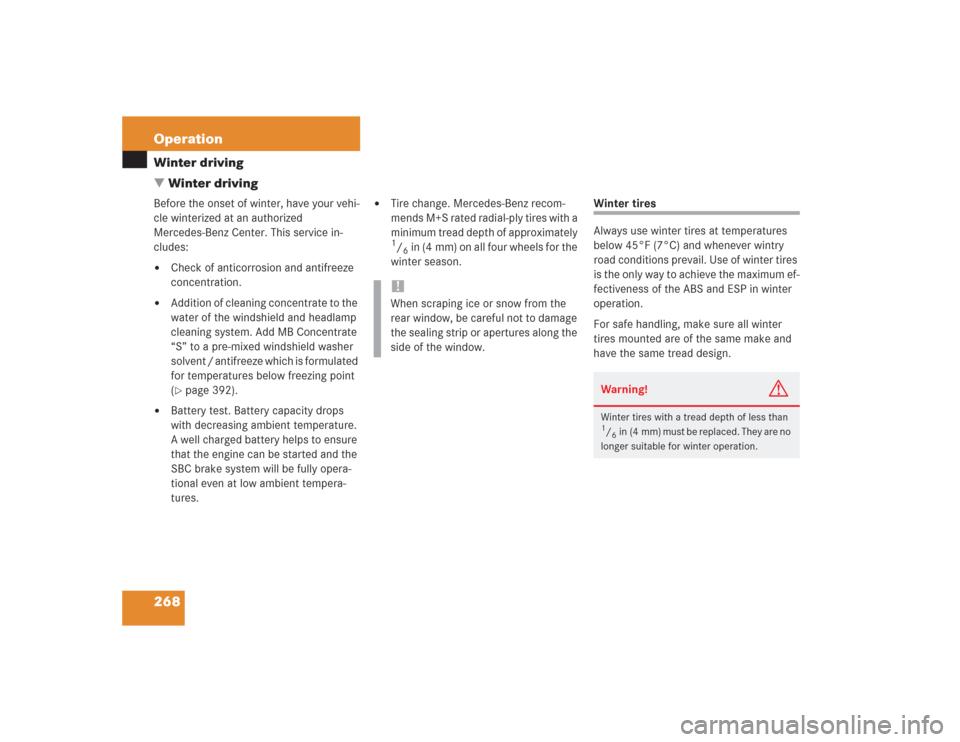
268 OperationWinter driving
�Winter drivingBefore the onset of winter, have your vehi-
cle winterized at an authorized
Mercedes-Benz Center. This service in-
cludes:�
Check of anticorrosion and antifreeze
concentration.
�
Addition of cleaning concentrate to the
water of the windshield and headlamp
cleaning system. Add MB Concentrate
“S” to a pre-mixed windshield washer
solvent / antifreeze which is formulated
for temperatures below freezing point
(�page 392).
�
Battery test. Battery capacity drops
with decreasing ambient temperature.
A well charged battery helps to ensure
that the engine can be started and the
SBC brake system will be fully opera-
tional even at low ambient tempera-
tures.
�
Tire change. Mercedes-Benz recom-
mends M+S rated radial-ply tires with a
minimum tread depth of approximately 1/6in (4 mm) on all four wheels for the
winter season.
Winter tires
Always use winter tires at temperatures
below 45°F (7°C) and whenever wintry
road conditions prevail. Use of winter tires
is the only way to achieve the maximum ef-
fectiveness of the ABS and ESP in winter
operation.
For safe handling, make sure all winter
tires mounted are of the same make and
have the same tread design.
!When scraping ice or snow from the
rear window, be careful not to damage
the sealing strip or apertures along the
side of the window.
Warning!
G
Winter tires with a tread depth of less than 1/6in (4 mm) must be replaced. They are no
longer suitable for winter operation.
Page 283 of 434
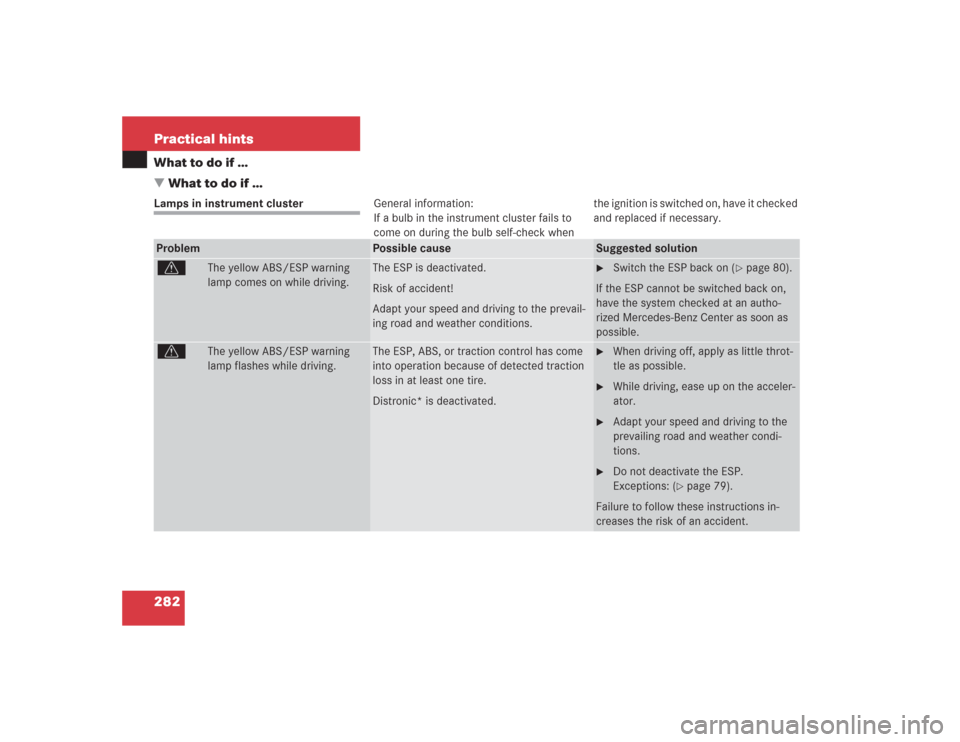
282 Practical hintsWhat to do if …
�What to do if …Lamps in instrument clusterGeneral information:
If a bulb in the instrument cluster fails to
come on during the bulb self-check when the ignition is switched on, have it checked
and replaced if necessary.Problem
Possible cause
Suggested solution
v
The yellow ABS/ESP warning
lamp comes on while driving.
The ESP is deactivated.
Risk of accident!
Adapt your speed and driving to the prevail-
ing road and weather conditions.
�
Switch the ESP back on (
�page 80).
If the ESP cannot be switched back on,
have the system checked at an autho-
rized Mercedes-Benz Center as soon as
possible.
v
The yellow ABS/ESP warning
lamp flashes while driving.
The ESP, ABS, or traction control has come
into operation because of detected traction
loss in at least one tire.
Distronic* is deactivated.
�
When driving off, apply as little throt-
tle as possible.
�
While driving, ease up on the acceler-
ator.
�
Adapt your speed and driving to the
prevailing road and weather condi-
tions.
�
Do not deactivate the ESP.
Exceptions: (
�page 79).
Failure to follow these instructions in-
creases the risk of an accident.
Page 284 of 434

283 Practical hints
What to do if …
Problem
Possible cause
Suggested solution
-
The yellow ABS indicator lamp
comes on while driving.
The ABS has detected a malfunction and has
switched off. The BAS and the ESP are also
switched off (see messages in display).
The SBC brake system is still functioning nor-
mally but without ABS available.
If the ABS control unit is malfunctioning, oth-
er systems such as Parktronic*, Distronic*,
or the automatic transmission may also be
malfunctioning.
�
Continue driving with added caution.
Wheels may lock during hard braking,
reducing steering capability.
�
Have the system checked at an autho-
rized Mercedes-Benz Center as soon
as possible.
Failure to follow these instructions in-
creases the risk of an accident.
�
Read and observe messages in the
display (
�page 291).
The charging voltage has fallen below
10 volts and the ABS was switched off.
When the voltage is above this value
again, the ABS is operational again.�
If necessary, have the generator and
battery checked.
Page 294 of 434
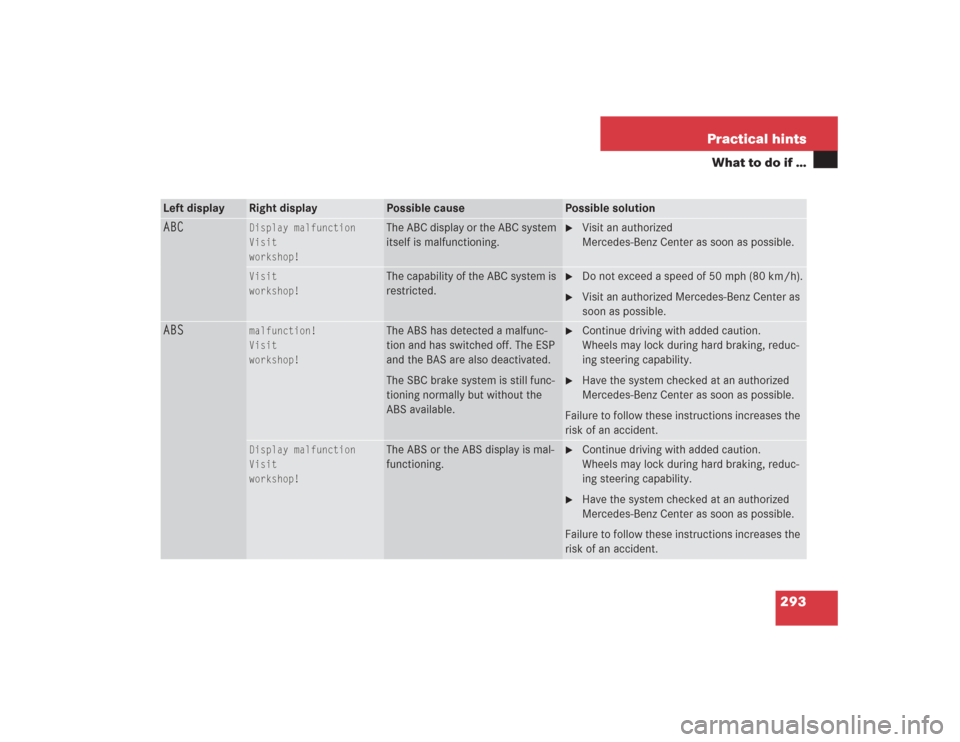
293 Practical hints
What to do if …
Left display
Right display
Possible cause
Possible solution
ABC
Display malfunction
Visit
workshop!
The ABC display or the ABC system
itself is malfunctioning.
�
Visit an authorized
Mercedes-Benz Center as soon as possible.
Visit
workshop!
The capability of the ABC system is
restricted.
�
Do not exceed a speed of 50 mph (80 km/h).
�
Visit an authorized Mercedes-Benz Center as
soon as possible.
ABS
malfunction!
Visit
workshop!
The ABS has detected a malfunc-
tion and has switched off. The ESP
and the BAS are also deactivated.
The SBC brake system is still func-
tioning normally but without the
ABS available.
�
Continue driving with added caution.
Wheels may lock during hard braking, reduc-
ing steering capability.
�
Have the system checked at an authorized
Mercedes-Benz Center as soon as possible.
Failure to follow these instructions increases the
risk of an accident.
Display malfunction
Visit
workshop!
The ABS or the ABS display is mal-
functioning.
�
Continue driving with added caution.
Wheels may lock during hard braking, reduc-
ing steering capability.
�
Have the system checked at an authorized
Mercedes-Benz Center as soon as possible.
Failure to follow these instructions increases the
risk of an accident.
Page 295 of 434
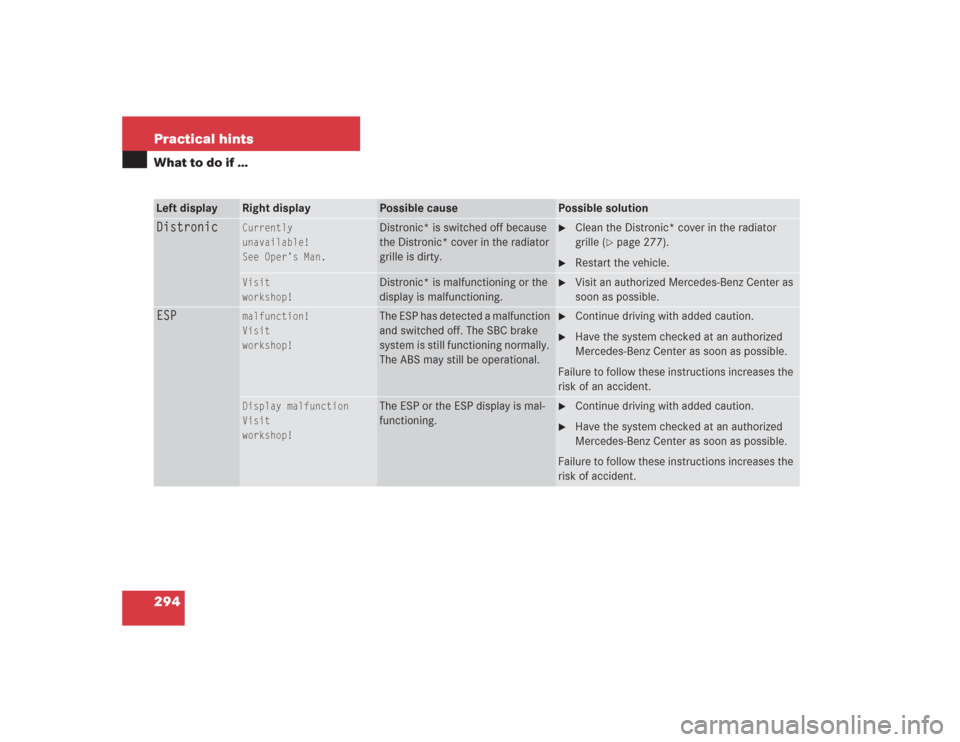
294 Practical hintsWhat to do if …Left display
Right display
Possible cause
Possible solution
Distronic
Currently
unavailable!
See Oper’s Man.
Distronic* is switched off because
the Distronic* cover in the radiator
grille is dirty.
�
Clean the Distronic* cover in the radiator
grille (
�page 277).
�
Restart the vehicle.
Visit
workshop!
Distronic* is malfunctioning or the
display is malfunctioning.
�
Visit an authorized Mercedes-Benz Center as
soon as possible.
ESP
malfunction!
Visit
workshop!
The ESP has detected a malfunction
and switched off. The SBC brake
system is still functioning normally.
The ABS may still be operational.
�
Continue driving with added caution.
�
Have the system checked at an authorized
Mercedes-Benz Center as soon as possible.
Failure to follow these instructions increases the
risk of an accident.
Display malfunction
Visit
workshop!
The ESP or the ESP display is mal-
functioning.
�
Continue driving with added caution.
�
Have the system checked at an authorized
Mercedes-Benz Center as soon as possible.
Failure to follow these instructions increases the
risk of accident.
Page 342 of 434
341 Practical hints
Flat tire
�
Shake contents of TIREFIT
container2.
�
Screw hose1 on to TIREFIT container
2.
TIREFIT is now ready for use.
1Valve stem
2Valve stem tool
3TIREFIT container
4Filler hose
5Filler hose plug
6Tire valve core
�
Unscrew the valve cap from valve1.
Warning!
G
Take care not to allow the contents of
TIREFIT to come in contact with hair, eyes or
clothing. TIREFIT is harmful if inhaled, swal-
lowed or absorbed through the skin - causes
skin, eye and respiratory irritation.
Any contact with eyes or skin should be
flushed immediately with plenty of water.
If clothing comes in contact with TIREFIT,
change clothing as soon as possible.
In case of allergic reaction or rash, consult a
physician immediately.
Warning!
G
Keep TIREFIT out of reach of children.
If swallowed, rinse mouth immediately with
plenty of water and drink plenty of water.
Do not induce vomiting!
Consult a physician immediately.
Keep away from open flame or heat source.
��